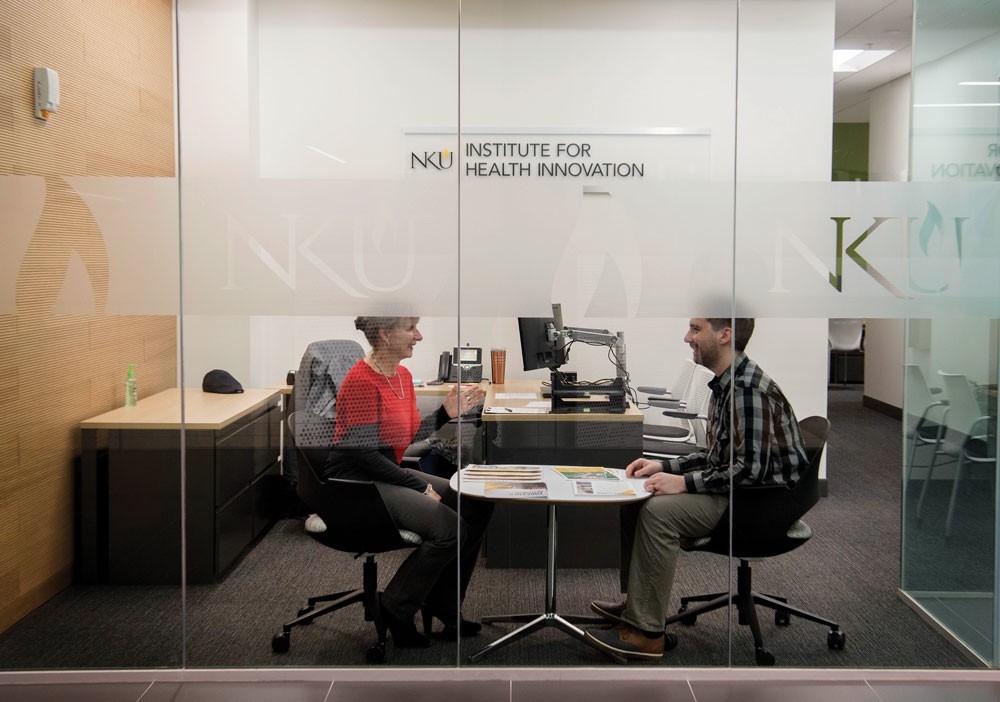

Established in 2018, NKU’s Institute for Health Innovation (IHI) was designed as a central hub for the university’s work on population health. Helming the IHI is St. Elizabeth Healthcare Executive Director and Vice President for Innovation, Dr. Valerie Gray Hardcastle, who was hired to bring the institute’s goals into reality.
“I think of myself as kind of a nudge and a convener, then a support system,” says Hardcastle. “What I can do, particularly with people working in the public service industry, is help them do their job more efficiently. We can study and crunch the data, see what works and what’s most effective.”
Conceived as an engine for improving population health, the institute exists to serve three defined purposes. The first is to engage the entire university, across multiple colleges and departments, in an “all-hands-on-deck” approach—Hardcastle likens the institute to the College of Informatics in this multidisciplinary methodology. The second is, quite simply, to make a difference in Kentucky’s population health by working directly with the community and helping to secure project funding. Finally, Hardcastle is tasked with serving student success, from attracting students to NKU all the way through graduating adults who are ready to serve their communities in a health-related capacity. This final point includes initiatives to identify challenges, such as housing insecurity, hunger and mental health, that commonly derail academic experiences and future careers.
With Kentucky in the grips of an addiction epidemic, much of the IHI’s work focuses on opioid use in the Commonwealth. Though she’s only been at NKU for a short time, Hardcastle is already elbow deep in plans to provide aid where Kentucky needs it most, starting with the recent receipt of a $200,000 federal planning grant from the Health Resources and Services Administration to help underserved areas struggling with addiction.
“One of the challenges of our rural areas is there’s just not enough access to health care,” she says, pointing to Owen County, site of the proposed Owen County Collaborative Addiction Treatment Initiative, which has only three full-time physicians and no dedicated behavioral health provider. “Anything related to addiction treatment beyond some minimal one-on-one counseling gets referred out of the county,” she says. “But there are no major roads that go through there, so that’s a big ask. Then if you’re working in a job that pays hourly, you’re going to have to take off a lot of hours to travel out of the county to get help—you can see the problem.”
In an area lacking sufficient population numbers to sustain profitable health care practices, finding a way to provide care is key to improving outcomes. “My hope is that we can set up clinical sites there,” says Hardcastle, “so we can have a health care provider there overseeing it, but then our students can rotate through as they need to for their internships and practicums and so forth. That could be a good way to provide low-cost or no-cost health care in areas of significant need.”
Another goal of the grant is training programs to help teachers and workers in Kentucky middle and high schools recognize and respond to student opioid use. “One of the things that we know now about the opioid epidemic, at least in this area, is that younger and younger people are showing up in the emergency department with an overdose,” she says. “A lot of money is being dumped into prevention, the ‘Just Say No to Drugs’ avenue, and a lot of money is being dumped into what happens when you overdose and we get you into treatment and you get healthy. But there’s this whole middle range of when people are using but they’re not in trouble yet. If we can catch them then, perhaps we can divert them from a very expensive tour through our health care industry.”
Hardcastle is also involved with the Ohio River Valley Addiction Research Consortium (ORVARC), which focuses on neonatal abstinence syndrome, the in-utero effects of opioids on fetal development. “We’re starting to work with St. Elizabeth on analyzing some data,” she says, “because now we’ve had enough children born and we’ve followed them around long enough that we can at least look at their diagnoses and see if we can find patterns. Then we can hopefully work together to find what is the best thing to do.”
With the daunting task of saving lives before her, it’s natural to wonder what Hardcastle’s personal benchmark for success would be. With the total elimination of addiction an unlikely scenario, what percentage would make her say, “Mission accomplished?”
“I don’t know that I can tell you, well, if we cut opioid deaths by 20 percent I would die happy,” she says, “I feel like that kind of work is never done. But if people could really understand that addiction is a chronic illness, like diabetes or heart disease, and should be treated as such, then I would say, ‘OK, I can die happy.’ People would not think of addiction as something you can just get over. So I think if somehow I could engineer this cultural shift on how we approach addiction, then I could say, ‘Yes, we’ve actually made a permanent difference.’”
